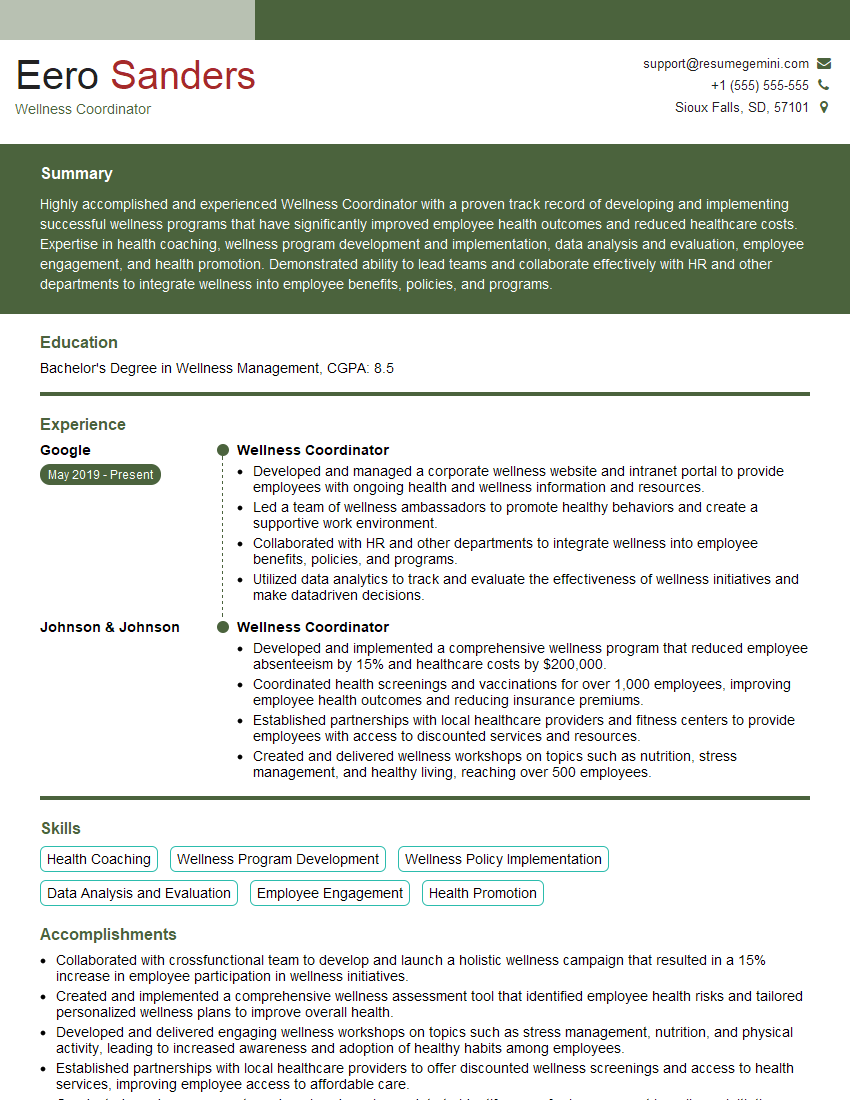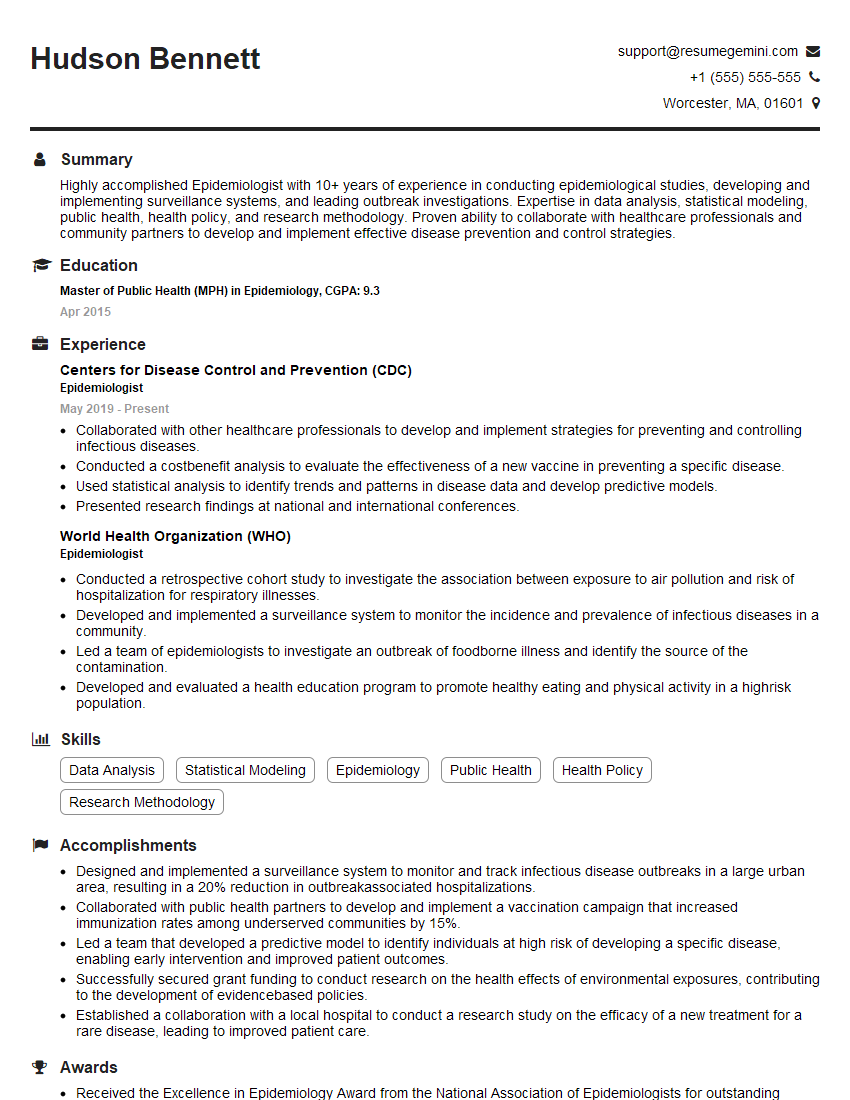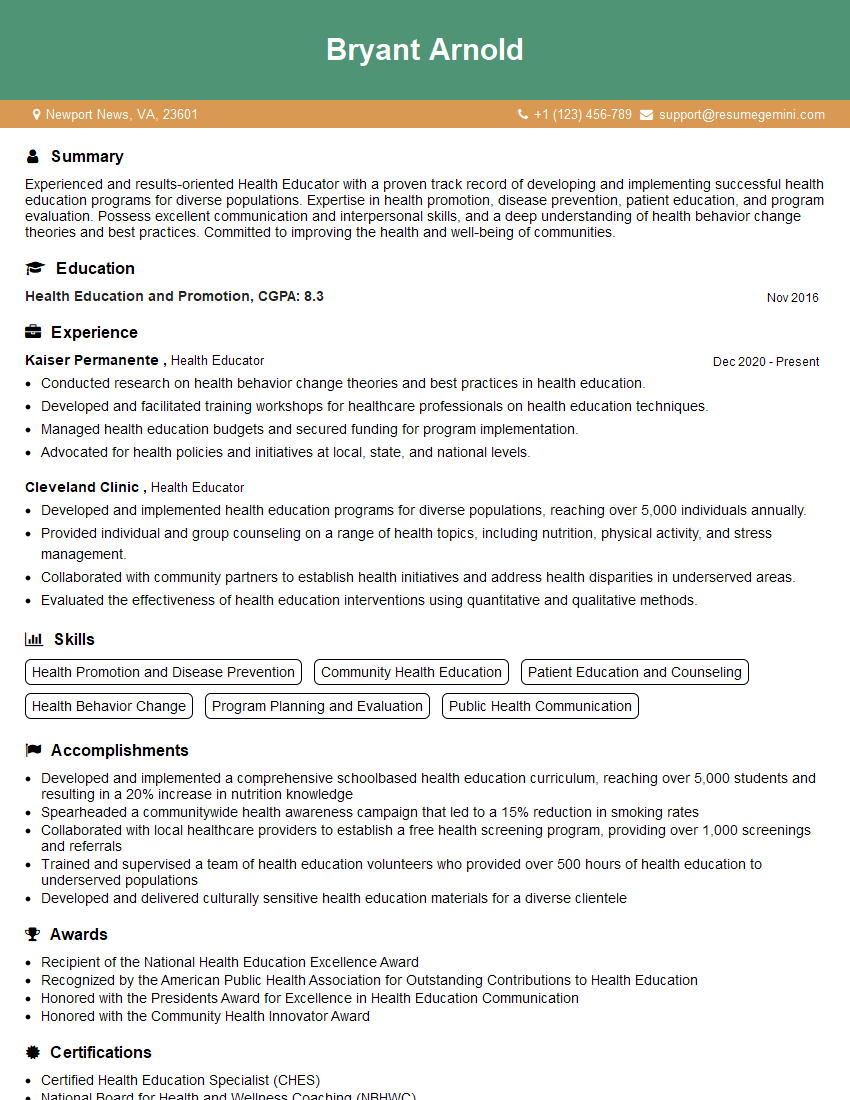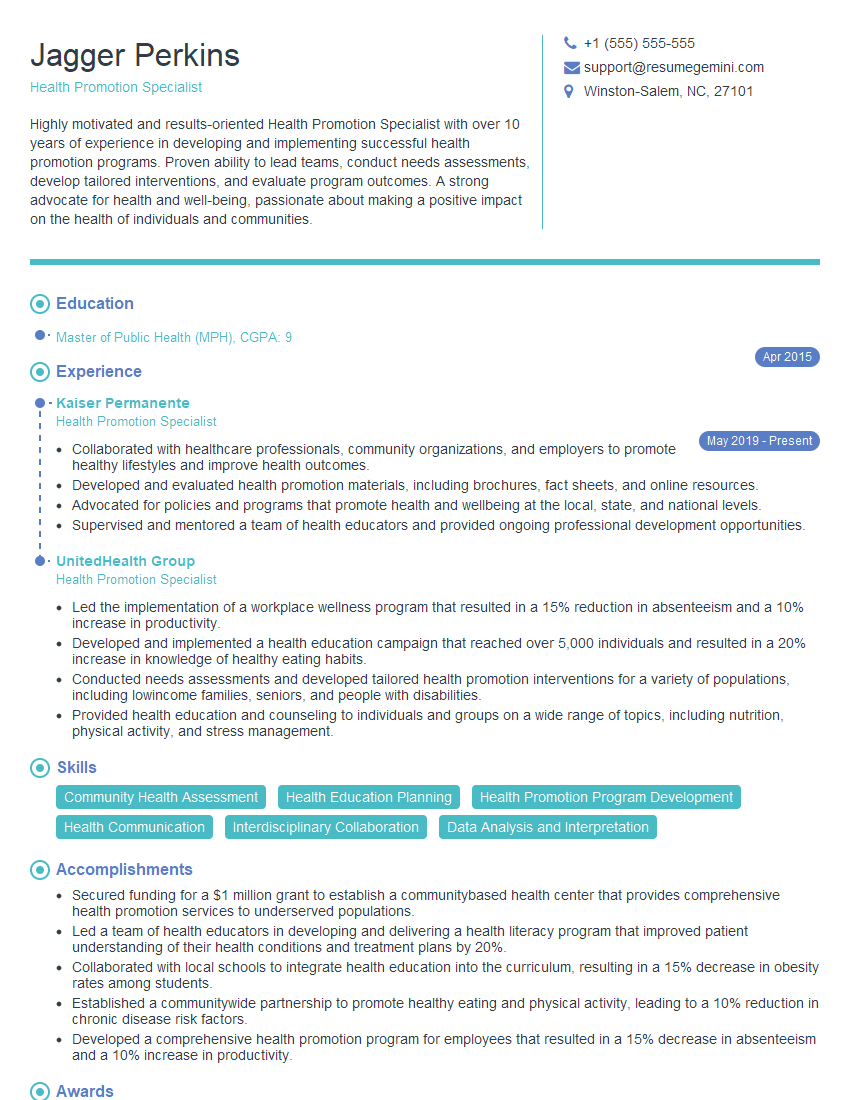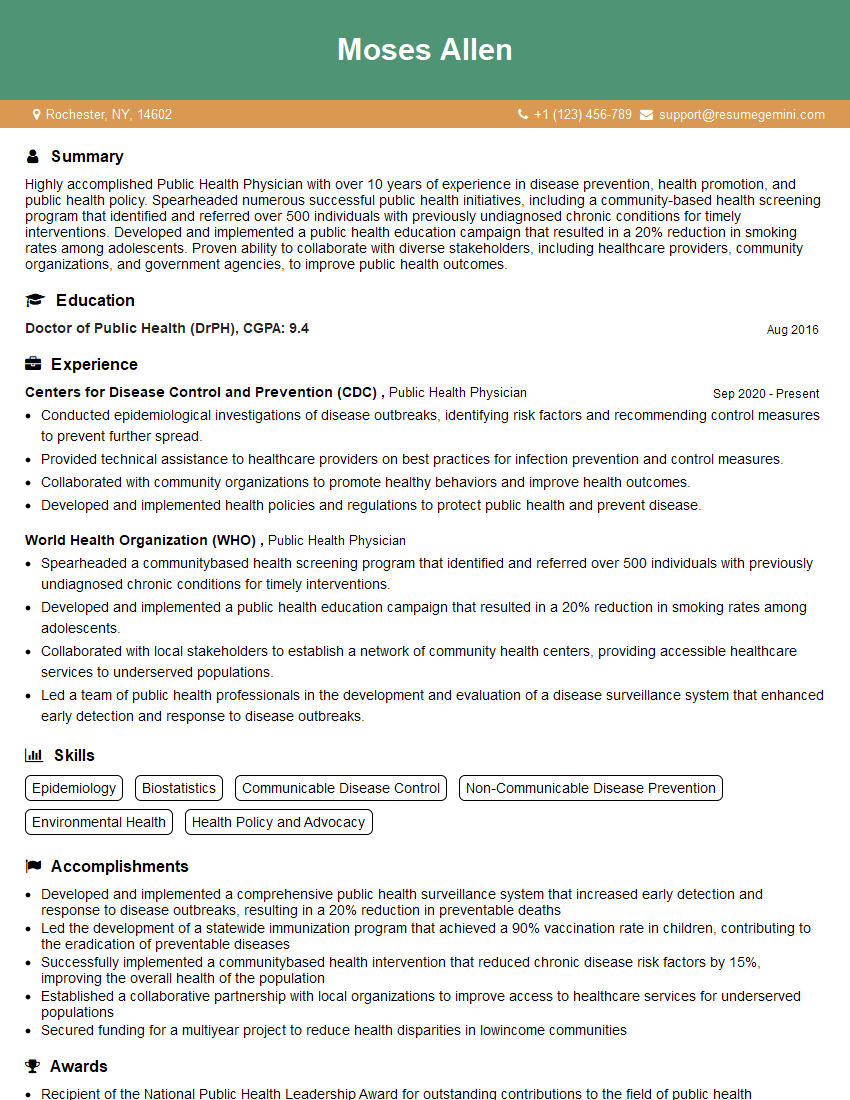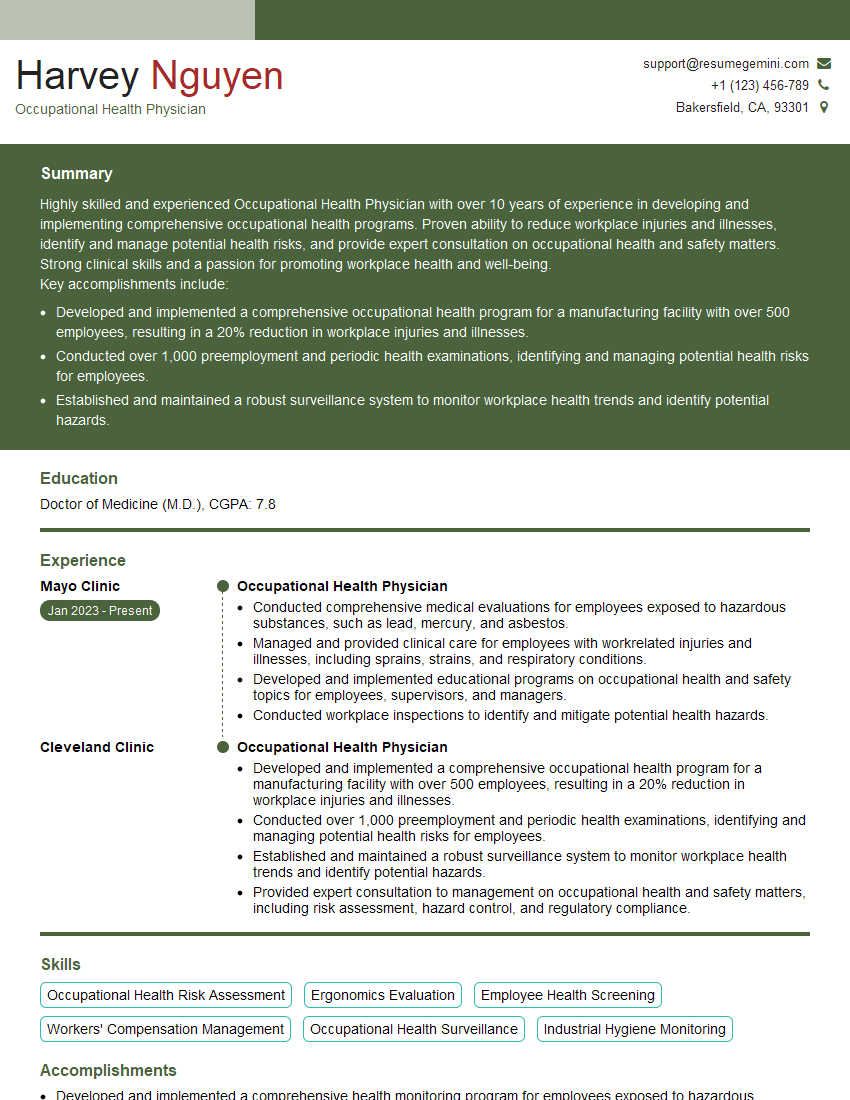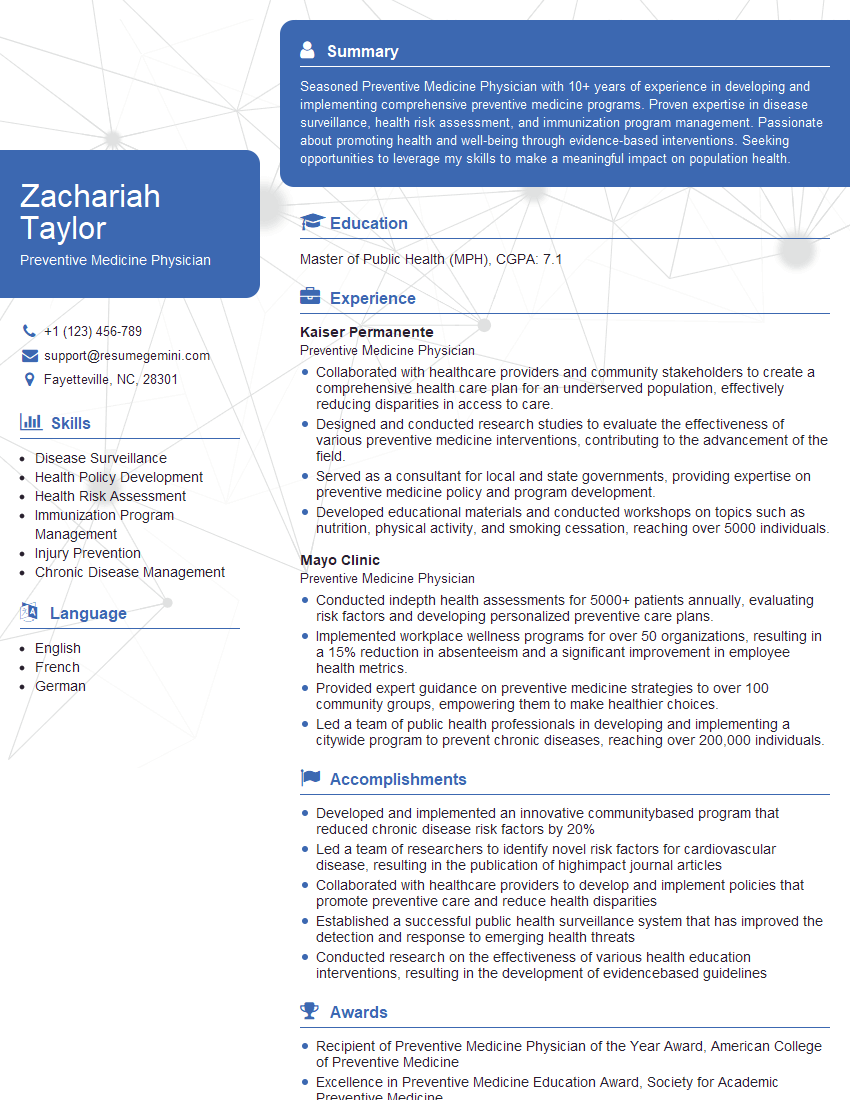Every successful interview starts with knowing what to expect. In this blog, we’ll take you through the top Preventive Medicine and Health Maintenance interview questions, breaking them down with expert tips to help you deliver impactful answers. Step into your next interview fully prepared and ready to succeed.
Questions Asked in Preventive Medicine and Health Maintenance Interview
Q 1. Explain the difference between primary, secondary, and tertiary prevention.
Preventive medicine employs a tiered approach to preventing disease and promoting health. Think of it like a three-part defense system.
- Primary Prevention: This focuses on preventing disease *before* it even starts. It’s about creating a healthy foundation. Examples include vaccination to prevent infectious diseases, promoting healthy diets and regular exercise to prevent heart disease and diabetes, and wearing seatbelts to prevent injuries in car accidents. It’s proactive and aims to reduce risk factors.
- Secondary Prevention: This aims to detect diseases *early*, before they cause significant damage. The focus here is on early diagnosis and prompt treatment. Examples include regular blood pressure and cholesterol checks, mammograms for breast cancer detection, and colonoscopies for colorectal cancer screening. The goal is to catch problems early, making them easier to treat.
- Tertiary Prevention: This stage focuses on managing *existing* diseases to prevent complications and improve quality of life. It aims to slow disease progression, reduce symptoms, and prevent further damage. Examples include rehabilitation after a stroke to regain lost function, diabetes management to prevent complications like blindness or kidney failure, and cardiac rehabilitation following a heart attack. It’s about managing the disease’s impact.
In essence, primary prevention is about avoiding the problem, secondary prevention is about finding it early, and tertiary prevention is about managing it effectively.
Q 2. Describe the significance of health screenings in preventive medicine.
Health screenings are the cornerstone of secondary prevention. They are crucial in preventive medicine because they allow for the early detection of diseases, often before any noticeable symptoms appear. Early detection significantly increases the chances of successful treatment and improves patient outcomes. For instance, detecting hypertension (high blood pressure) early through regular screenings can prevent future strokes and heart attacks. Similarly, early detection of colon cancer through colonoscopies allows for timely intervention, significantly improving survival rates.
The significance also lies in cost-effectiveness. Treating a disease in its early stages is generally less expensive and less invasive than managing an advanced disease. Screenings help to identify individuals at high risk, allowing for targeted interventions and lifestyle modifications to further reduce the risk of developing the disease.
Q 3. What are the key components of a comprehensive health risk assessment?
A comprehensive health risk assessment is a detailed evaluation of an individual’s risk factors for developing specific diseases. It goes beyond simple measurements and delves into various aspects of one’s life to create a personalized risk profile. Key components usually include:
- Personal History: This includes family history of diseases, current medications, previous illnesses and surgeries, and allergies.
- Lifestyle Factors: This encompasses diet, physical activity level, smoking status, alcohol consumption, and sleep patterns.
- Physical Examination: This includes measurements like height, weight, blood pressure, and waist circumference.
- Laboratory Tests: This may involve blood tests to measure cholesterol, blood sugar, and other relevant biomarkers.
- Psychosocial Factors: This assesses stress levels, social support, and mental health status, as these can significantly impact overall health.
The data gathered is then used to calculate the individual’s risk for various conditions, such as heart disease, diabetes, and certain cancers. This allows for personalized recommendations for prevention and management.
Q 4. How would you approach designing a workplace wellness program?
Designing a successful workplace wellness program requires a multi-faceted approach. It’s not just about offering gym memberships; it’s about creating a culture of health.
- Needs Assessment: Start by surveying employees to understand their health interests and needs. What are their biggest health concerns? What kind of programs would they find most appealing?
- Program Development: Based on the assessment, design a program with diverse offerings. Consider options like health screenings, educational workshops on nutrition and stress management, on-site fitness facilities or subsidized gym memberships, and smoking cessation programs.
- Implementation and Promotion: Make sure the program is easily accessible and actively promoted. Communicate its benefits clearly to employees, and provide ongoing support and encouragement.
- Evaluation and Improvement: Track participation rates, employee feedback, and changes in health outcomes to assess the program’s effectiveness. Regularly review and adjust the program to meet evolving employee needs and maximize impact.
A key to success is management support and creating an environment where healthy choices are easy and encouraged. Small, achievable steps often lead to greater sustained success.
Q 5. Discuss the role of lifestyle modifications in preventing chronic diseases.
Lifestyle modifications are pivotal in preventing chronic diseases. Many chronic conditions like heart disease, type 2 diabetes, and some cancers are largely preventable through changes in diet, exercise, and overall lifestyle. Think of it as ‘preemptive maintenance’ for your body.
- Diet: A balanced diet rich in fruits, vegetables, whole grains, and lean proteins is crucial. Limiting processed foods, saturated and trans fats, and added sugars is equally important.
- Physical Activity: Regular physical activity, such as at least 150 minutes of moderate-intensity aerobic exercise per week, is essential for maintaining a healthy weight, improving cardiovascular health, and reducing the risk of many chronic diseases.
- Stress Management: Chronic stress can significantly impact health. Techniques like yoga, meditation, and deep breathing exercises can help manage stress levels.
- Smoking Cessation: Quitting smoking is one of the most impactful lifestyle changes a person can make to improve their health and reduce their risk of various diseases.
- Alcohol Consumption: Moderate alcohol consumption, if any, is recommended. Excessive drinking increases the risk of various health problems.
These changes, while seemingly simple, can have profound and long-lasting effects on health, significantly reducing the risk of developing and managing chronic diseases. It’s an investment in one’s future health and well-being.
Q 6. What are the current guidelines for cholesterol screening and management?
Current cholesterol screening and management guidelines vary depending on individual risk factors and age, but generally involve:
- Screening: The American Heart Association recommends that most adults aged 20 and older have their cholesterol levels checked every 4-6 years. More frequent screening is advised for individuals with high risk factors such as family history of premature heart disease, diabetes, smoking, or hypertension.
- Management: Treatment focuses on lifestyle modifications, such as dietary changes (reducing saturated and trans fats, increasing fiber intake) and increased physical activity. If lifestyle changes aren’t enough to lower cholesterol, medication, such as statins, may be prescribed. The goal is to achieve optimal levels of LDL cholesterol (‘bad’ cholesterol) and HDL cholesterol (‘good’ cholesterol) to reduce the risk of cardiovascular disease.
Specific targets for LDL and HDL cholesterol levels are determined based on individual risk profiles. It’s vital to consult with a healthcare professional to determine an appropriate screening and management plan.
Q 7. Explain the importance of vaccination in preventive medicine.
Vaccination is a cornerstone of preventive medicine. It’s one of the most cost-effective and successful public health interventions ever developed. Vaccinations protect individuals and communities from vaccine-preventable diseases (VPDs).
The importance lies in:
- Disease Prevention: Vaccinations work by stimulating the immune system to produce antibodies against specific pathogens, preventing or reducing the severity of infections.
- Herd Immunity: When a large percentage of the population is vaccinated, it creates ‘herd immunity,’ protecting even those who cannot be vaccinated due to medical reasons (e.g., immunocompromised individuals). This dramatically reduces the spread of infectious diseases.
- Reduced Healthcare Costs: Preventing diseases through vaccination avoids the significant costs associated with treating illness, hospitalization, and long-term complications.
- Public Health Security: Vaccination programs play a crucial role in preventing outbreaks of infectious diseases and protecting public health security.
Staying up-to-date with recommended vaccinations is crucial for individual and community health. Vaccination is a powerful tool to safeguard against many serious and potentially life-threatening diseases.
Q 8. How do you counsel patients on healthy eating habits?
Counseling patients on healthy eating involves a collaborative, patient-centered approach. It’s not about dictating a diet, but guiding them towards sustainable lifestyle changes. I begin by understanding their current eating habits, preferences, and any cultural or religious considerations. This involves open-ended questions like, “Tell me about a typical day of eating for you.” Then, I use the principles of the Dietary Guidelines for Americans, emphasizing a balanced diet rich in fruits, vegetables, whole grains, and lean protein, while limiting saturated and trans fats, added sugars, and sodium.
I often use the MyPlate visual guide as a helpful tool to demonstrate portion sizes and food group distribution. I might also introduce the concept of mindful eating – paying attention to hunger and fullness cues, eating slowly, and savoring food. For example, if a patient enjoys pasta, I’ll guide them towards whole wheat pasta and suggest incorporating more vegetables into the dish. Instead of eliminating treats entirely, I’ll help them find healthier alternatives and practice moderation. The goal is to empower them to make informed choices that align with their individual needs and preferences.
Furthermore, I always consider potential barriers like food insecurity, limited cooking skills, or cultural food traditions and address them appropriately, connecting them with resources as needed, such as cooking classes or food banks.
Q 9. Describe your approach to motivating patients to adopt healthy behaviors.
Motivating patients to adopt healthy behaviors requires building a strong therapeutic alliance based on trust and mutual respect. I use motivational interviewing techniques, focusing on their intrinsic motivation rather than imposing external pressure. This means exploring their reasons for wanting to change, acknowledging their ambivalence, and supporting their self-efficacy – their belief in their ability to succeed. I avoid judgmental language and instead use empathetic listening and reflective statements to help them articulate their own goals and identify potential obstacles.
Setting SMART goals (Specific, Measurable, Achievable, Relevant, and Time-bound) is crucial. For example, instead of a vague goal like “eat healthier,” we might aim for “eat at least five servings of fruits and vegetables daily for the next two weeks.” We regularly track progress, celebrating small victories and adjusting strategies as needed. I also emphasize the long-term benefits of healthy behaviors, focusing on improved energy levels, reduced risk of chronic diseases, and enhanced quality of life. Regular follow-up appointments and encouragement are essential to reinforce positive changes and provide ongoing support.
Q 10. What are the common barriers to preventive health care?
Many barriers hinder access to and engagement in preventive healthcare. These can be categorized into individual, social, and system-level barriers.
- Individual barriers: Lack of awareness about preventive services, perceived invulnerability, fear, mistrust of healthcare providers, financial constraints, lack of transportation, and low health literacy.
- Social barriers: Cultural beliefs and practices that may not prioritize preventive care, social isolation, lack of social support, and discrimination based on race, ethnicity, or socioeconomic status.
- System-level barriers: Limited access to preventive services, long wait times, inconvenient clinic hours, high cost of services, inadequate insurance coverage, and a shortage of healthcare professionals, particularly in underserved communities.
Overcoming these barriers requires a multi-pronged approach, addressing each level individually.
Q 11. How would you address patient resistance to recommended preventive measures?
Addressing patient resistance requires patience, understanding, and skillful communication. It’s important to first understand the reasons behind their resistance. This might involve exploring their beliefs, concerns, and past experiences with healthcare. Instead of directly confronting their resistance, I use empathetic listening and reflective statements to show that I understand their perspective. For instance, if a patient is hesitant about a recommended screening test, I might say, “I hear you’re concerned about the potential discomfort and inconvenience. Let’s talk about those concerns.”
I then collaboratively work with them to address their concerns, providing accurate information, answering their questions honestly, and empowering them to make informed decisions. I might share stories of others who have benefited from the preventive measure or highlight the potential long-term consequences of inaction. If the resistance persists, I respect their autonomy, but I document my efforts to educate and encourage them, and provide resources for future consideration.
Q 12. Discuss the ethical considerations of preventive medicine interventions.
Ethical considerations in preventive medicine are multifaceted. Autonomy is paramount – respecting the patient’s right to make informed decisions about their own health, even if those decisions differ from medical recommendations. Beneficence guides us to act in the patient’s best interest, balancing the potential benefits of interventions with their risks and side effects. Non-maleficence requires us to avoid causing harm. Justice mandates equitable access to preventive services, regardless of socioeconomic status, race, ethnicity, or other factors.
Ethical dilemmas arise when considering the allocation of resources, the potential for over-testing and overtreatment, and the impact of preventive interventions on individual liberties. For example, mandatory vaccination policies raise questions about individual autonomy versus public health. Navigating these complexities requires careful consideration of ethical principles, shared decision-making, and ongoing reflection on our practices.
Q 13. Explain the role of technology in delivering preventive health services.
Technology plays a transformative role in delivering preventive health services. Electronic health records (EHRs) allow for efficient tracking of preventive care measures, sending automated reminders for screenings and immunizations. Telehealth platforms enable remote consultations, making preventive care more accessible, especially for individuals in rural or underserved areas. Wearable devices and mobile health apps can monitor vital signs, physical activity levels, and sleep patterns, providing personalized feedback and promoting behavior change.
Artificial intelligence (AI) is being used to develop risk prediction models and personalize preventive recommendations. For example, AI algorithms can analyze patient data to identify individuals at high risk for certain diseases, enabling targeted interventions. Data analytics can identify population-level health trends and inform public health strategies. The integration of technology into preventive care enhances efficiency, accessibility, and personalization, ultimately improving health outcomes.
Q 14. How do you stay current with the latest advancements in preventive medicine?
Staying current in preventive medicine requires a multifaceted approach. I regularly review peer-reviewed journals like the Journal of Preventive Medicine and American Journal of Public Health. I actively participate in continuing medical education (CME) activities, attending conferences, webinars, and workshops offered by organizations like the Centers for Disease Control and Prevention (CDC) and the American College of Preventive Medicine. I also follow reputable health organizations and governmental agencies on social media and their websites for the latest updates and guidelines.
I maintain a network of colleagues and experts in the field, engaging in discussions and knowledge sharing. I utilize online resources like PubMed and Google Scholar to access the latest research findings. Critical appraisal of information is crucial, ensuring that I rely on evidence-based sources and avoid misinformation. Continuous learning is fundamental to providing the most effective and up-to-date preventive care services.
Q 15. Describe your experience with data analysis in preventive medicine.
Data analysis is fundamental to preventive medicine. It allows us to identify trends, risk factors, and the effectiveness of interventions. My experience encompasses using various statistical methods and software (like R and SAS) to analyze large datasets, including patient records, epidemiological surveys, and public health data. For example, I’ve analyzed health screening data to identify populations at high risk for specific conditions like diabetes or heart disease, allowing for targeted preventive strategies. Another project involved analyzing data from a community-based intervention program to assess its impact on smoking cessation rates.
This analysis goes beyond simply crunching numbers; it involves interpreting the results within their epidemiological context, considering factors like confounding variables and limitations in data quality. The goal is always to use data to inform evidence-based practices and improve public health outcomes.
Career Expert Tips:
- Ace those interviews! Prepare effectively by reviewing the Top 50 Most Common Interview Questions on ResumeGemini.
- Navigate your job search with confidence! Explore a wide range of Career Tips on ResumeGemini. Learn about common challenges and recommendations to overcome them.
- Craft the perfect resume! Master the Art of Resume Writing with ResumeGemini’s guide. Showcase your unique qualifications and achievements effectively.
- Don’t miss out on holiday savings! Build your dream resume with ResumeGemini’s ATS optimized templates.
Q 16. How do you interpret and communicate epidemiological data?
Interpreting epidemiological data involves understanding the measures of disease frequency (incidence and prevalence), measures of association (relative risk and odds ratio), and assessing the validity and reliability of the data itself. For example, a high relative risk of lung cancer in smokers compared to non-smokers strengthens the causal link between smoking and lung cancer. However, we also need to consider confounding factors like genetics or exposure to asbestos.
Communicating this data effectively requires clear, concise language tailored to the audience. For policymakers, I might use summary statistics and visual aids like charts and graphs. For the public, I might focus on the implications of the findings in terms of individual risk and preventative actions. For example, conveying the simple message of ‘smoking increases your risk of lung cancer’ is more effective for the general public than a detailed statistical analysis.
Q 17. Explain your understanding of health disparities and health equity.
Health disparities refer to the preventable differences in the burden of disease, injury, violence, or opportunities to achieve optimal health that are experienced by socially disadvantaged populations. Health equity, on the other hand, is the absence of those disparities. It’s not just about equal access to healthcare, but also about ensuring that everyone has the opportunity to attain their full health potential. Think of it like a race: health equity means everyone starts at the same starting line, with equal resources, and has an equal chance to finish.
Examples of health disparities include higher rates of heart disease in low-income communities, limited access to mental healthcare in rural areas, and higher maternal mortality rates among racial and ethnic minorities. Addressing these disparities requires understanding the social determinants of health—factors like poverty, education, housing, and environmental conditions—that significantly impact health outcomes.
Q 18. What are some effective strategies for promoting health literacy?
Promoting health literacy involves empowering individuals to understand and use health information to make informed decisions about their health. Strategies include:
- Clear and concise communication: Using plain language, avoiding medical jargon, and providing visual aids.
- Tailored messaging: Considering the cultural background, literacy level, and health beliefs of the target audience.
- Interactive tools and resources: Using infographics, videos, and online resources to engage people.
- Community-based programs: Offering workshops, health fairs, and educational materials in accessible settings.
- Empowering patients: Encouraging questions and actively involving individuals in their healthcare decisions.
For example, a health literacy program might use simple infographics to explain the benefits of regular exercise or develop culturally sensitive materials on diabetes prevention for a specific ethnic community.
Q 19. How would you evaluate the effectiveness of a preventive medicine program?
Evaluating a preventive medicine program involves a multi-faceted approach using both quantitative and qualitative methods. We need to assess the program’s reach (how many people it impacted), effectiveness (did it achieve its goals), efficiency (was it cost-effective), and sustainability (can it continue long-term).
Quantitative methods might involve analyzing changes in key health indicators (e.g., blood pressure, cholesterol levels, smoking rates) before and after the intervention. Statistical tests can determine the significance of any observed changes. Qualitative methods might include surveys, focus groups, and interviews to gather feedback from participants and understand their experiences. A cost-effectiveness analysis would compare the program’s cost to the health benefits it generated. Ultimately, a successful evaluation provides data-driven insights to improve program design and implementation for future iterations.
Q 20. Describe your experience with community health outreach initiatives.
I’ve been actively involved in several community health outreach initiatives. One project involved collaborating with local health clinics to organize health fairs offering free screenings for blood pressure, cholesterol, and diabetes. We also provided educational materials and counseling on healthy lifestyles. Another initiative focused on developing culturally sensitive educational resources to address health disparities in a specific immigrant community. These projects often involve partnerships with community organizations, healthcare providers, and local leaders to ensure the initiatives are relevant and effective.
The key to successful community outreach is building trust and rapport with the community, understanding their unique needs, and working collaboratively with them to develop and implement sustainable programs.
Q 21. Discuss the role of public health agencies in preventive medicine.
Public health agencies play a crucial role in preventive medicine. Their responsibilities include:
- Surveillance and monitoring: Tracking disease trends and identifying outbreaks.
- Risk assessment: Identifying and evaluating public health threats.
- Policy development and advocacy: Creating and implementing policies to promote health and prevent disease.
- Health promotion and education: Educating the public about health risks and preventive measures.
- Disease prevention and control: Implementing programs to prevent and control infectious and chronic diseases.
For example, the Centers for Disease Control and Prevention (CDC) in the US plays a critical role in tracking infectious disease outbreaks, developing vaccination programs, and educating the public about health issues. These agencies are instrumental in protecting and improving population health through preventative strategies.
Q 22. How would you address a potential outbreak of an infectious disease?
Addressing a potential infectious disease outbreak requires a swift and coordinated multi-pronged approach. It’s akin to fighting a fire – you need to contain the blaze, prevent its spread, and treat those affected.
Surveillance and Detection: The first step is robust surveillance to quickly identify cases. This involves close monitoring of illness reports from healthcare providers and the public, laboratory testing to confirm diagnoses, and utilizing epidemiological tools to map the spread.
Containment and Control: Once a case is confirmed, immediate isolation or quarantine measures must be implemented to limit contact with others. Contact tracing is crucial to identify and monitor individuals who may have been exposed, providing them with preventive measures and monitoring for symptoms.
Public Health Communication: Clear, concise, and accurate communication to the public is vital to reduce fear and promote compliance with public health recommendations. This includes providing regular updates on the situation, explaining preventive measures such as hand hygiene and social distancing, and addressing misinformation.
Treatment and Supportive Care: Providing appropriate medical care to those infected is paramount. This involves administering antiviral medications if available, offering supportive care to manage symptoms, and ensuring access to quality healthcare services.
Post-Outbreak Evaluation: Once the outbreak is contained, a thorough review of the response is necessary to identify areas for improvement in future preparedness and response efforts. This often involves evaluating the effectiveness of control measures and identifying any gaps in the public health infrastructure.
For example, during a measles outbreak, I would immediately implement a vaccination campaign targeting susceptible individuals and those in close contact with infected patients, coupled with stringent isolation measures for those infected.
Q 23. What is your experience with patient education and counseling?
Patient education and counseling are central to preventive medicine. I believe in empowering patients to actively participate in their own health journey. My approach involves using plain language, tailoring information to individual needs and literacy levels, and employing various educational methods.
Interactive Sessions: I utilize interactive sessions, incorporating visual aids, demonstrations, and real-life scenarios to enhance understanding. For example, when explaining the benefits of regular exercise, I might use a chart illustrating the relationship between physical activity and reduced risk of chronic diseases.
Personalized Plans: I co-create personalized prevention plans with patients, ensuring their goals and preferences are reflected. This might include setting realistic targets for dietary changes or creating a structured exercise program.
Follow-up and Support: I provide ongoing support through regular follow-up appointments, answering questions and addressing concerns. I might use phone calls, emails, or online platforms to maintain consistent contact and encourage adherence to prevention strategies.
Collaboration: I believe in collaborating with other healthcare professionals, community resources, and family members to provide holistic support and address social determinants of health that can influence adherence to preventative strategies.
For instance, I once worked with a patient struggling with diabetes. Through regular counseling sessions, tailored dietary recommendations, and close monitoring, we were able to help him manage his blood sugar levels effectively and minimize the risk of long-term complications.
Q 24. Describe your familiarity with different preventive care models.
My familiarity with preventive care models spans various approaches, each with its strengths and weaknesses.
Population-Based Approach: This focuses on preventing disease in entire populations through public health initiatives like vaccination campaigns and health promotion programs. For example, nationwide campaigns to promote flu vaccination or reduce smoking rates fall under this approach.
High-Risk Approach: This prioritizes identifying and intervening with individuals at higher risk of developing specific diseases. For instance, providing cholesterol-lowering medication to individuals with high cholesterol levels falls under this.
Multilevel Interventions: This approach recognizes that multiple factors influence health and targets interventions at various levels – individual, community, and societal. For example, a program to reduce childhood obesity could involve educating parents, providing healthy school meals, and improving community access to recreational facilities.
Health Coaching: This increasingly popular model focuses on empowering individuals to make sustainable lifestyle changes through personalized guidance and support. Health coaches work closely with clients to set achievable goals, develop action plans, and overcome barriers to positive behavior change.
A successful preventive care strategy often integrates elements from multiple models, tailoring the approach to the specific disease and population being addressed.
Q 25. Explain the importance of integrating preventive medicine into primary care.
Integrating preventive medicine into primary care is essential for shifting the focus from treating illness to maintaining health and well-being. It’s a proactive approach that can significantly reduce healthcare costs and improve overall population health.
Early Disease Detection: Preventive care allows for early detection of diseases through screenings and regular checkups, enabling prompt intervention and reducing the severity of disease progression. For example, regular Pap smears can detect cervical cancer at an early, treatable stage.
Reduced Healthcare Costs: By preventing diseases from developing or progressing, preventive care reduces the need for expensive treatments and hospitalizations down the line.
Improved Quality of Life: Preventive measures such as vaccination and lifestyle modifications can improve the quality of life by preventing disability, illness, and premature death.
Increased Patient Engagement: A proactive primary care approach emphasizes patient education and empowers individuals to become active participants in managing their health. This increased engagement leads to better outcomes.
Think of it as regular car maintenance – regular checkups, oil changes, and tire rotations prevent costly repairs and breakdowns down the road. Similarly, preventive care in primary settings prevents costly health issues later on.
Q 26. Discuss the role of social determinants of health in preventive care.
Social determinants of health (SDOH) significantly influence a person’s ability to adopt and maintain healthy behaviors. Ignoring these factors undermines even the most effective preventive strategies.
Economic Stability: Poverty and lack of access to affordable healthcare, healthy food, and safe housing can create significant barriers to preventive care. For instance, individuals living in food deserts may lack access to fresh produce, increasing their risk of obesity and related chronic diseases.
Education Access: Lower education levels often correlate with lower health literacy and a reduced understanding of preventive health measures. Effective health communication requires considering this variable.
Social and Community Context: Social isolation, lack of community support, and exposure to violence can negatively impact both physical and mental health, diminishing the effectiveness of preventive strategies.
Healthcare Access: Limited access to healthcare providers, insurance coverage, and transportation can prevent individuals from receiving necessary preventive services.
Addressing SDOH requires collaboration with community organizations, social workers, and other healthcare professionals to ensure that preventive interventions are culturally appropriate, accessible, and address the specific challenges faced by vulnerable populations. For example, a program to increase physical activity in a low-income neighborhood might involve partnering with local community centers to provide affordable fitness classes and creating safe walking paths.
Q 27. How would you use evidence-based practices to inform your preventive medicine strategies?
Evidence-based practices are fundamental to developing effective preventive medicine strategies. This means relying on the best available scientific evidence to guide decisions.
Systematic Reviews and Meta-analyses: I regularly consult systematic reviews and meta-analyses to assess the effectiveness of various preventive interventions. These provide a comprehensive overview of the existing research on a particular topic.
Clinical Practice Guidelines: I follow established clinical practice guidelines from reputable organizations such as the CDC and the WHO. These guidelines are developed by panels of experts and provide evidence-based recommendations for preventive services.
Data-Driven Decision Making: I use data collected from patient records and population health surveys to track the impact of preventive interventions and make data-driven adjustments to improve effectiveness.
Critical Appraisal of Evidence: I am adept at critically appraising research studies to evaluate their quality, validity, and applicability to my practice. This includes understanding study design, biases, and limitations.
For example, before recommending a specific screening test, I would review the available evidence on its sensitivity, specificity, and potential harms to ensure it is appropriate for the individual patient.
Q 28. Describe your approach to managing chronic conditions through preventive strategies.
Managing chronic conditions through preventive strategies focuses on slowing disease progression, minimizing complications, and improving quality of life. It’s a collaborative effort between the healthcare provider and the patient.
Lifestyle Modifications: This is a cornerstone of chronic disease management. For example, encouraging regular exercise, healthy eating, and smoking cessation in patients with diabetes or heart disease can significantly improve their outcomes.
Medication Adherence: Ensuring patients adhere to their prescribed medications is crucial. This might involve addressing potential barriers to adherence, such as cost or side effects, and providing support and education.
Regular Monitoring: Regular monitoring of vital signs, laboratory tests, and other clinical indicators helps to detect early signs of complications and adjust treatment plans as needed.
Self-Management Education: Empowering patients to manage their own health through education and skill-building is essential. This might include teaching patients how to monitor their blood sugar levels, administer insulin, or manage their medications effectively.
Patient-Centered Care: Adopting a patient-centered approach that recognizes individual needs and preferences is key to ensuring that patients are actively involved in their own care.
For example, working with a patient with hypertension might involve not just prescribing medication but also educating them about dietary changes, stress management techniques, and the importance of regular exercise to help control their blood pressure.
Key Topics to Learn for Preventive Medicine and Health Maintenance Interview
- Screening and Prevention Strategies: Understand the rationale, effectiveness, and limitations of various screening tests for common diseases (e.g., cancer, cardiovascular disease, diabetes). Be prepared to discuss cost-effectiveness and population-based screening programs.
- Health Promotion and Behavior Change: Discuss models of health behavior change (e.g., Transtheoretical Model, Health Belief Model) and their application in designing effective interventions. Consider practical examples of promoting healthy lifestyles (e.g., diet, exercise, smoking cessation).
- Disease Prevention and Control: Explain the principles of primary, secondary, and tertiary prevention. Be able to apply this framework to specific diseases and develop tailored prevention strategies.
- Public Health Surveillance and Epidemiology: Understand the role of surveillance in identifying and addressing public health threats. Discuss key epidemiological concepts relevant to preventive medicine, including incidence, prevalence, and risk factors.
- Health Policy and Advocacy: Discuss the impact of health policies on preventive health initiatives. Consider the ethical and social determinants of health impacting access to preventive care.
- Data Analysis and Interpretation: Demonstrate your ability to interpret and analyze epidemiological data, including understanding measures of association and statistical significance.
- Community Health and Global Health: Discuss the role of preventive medicine in addressing health disparities and improving population health at both the community and global levels.
- Ethical Considerations in Preventive Medicine: Explore ethical dilemmas related to screening, vaccination, and resource allocation in preventive care.
Next Steps
Mastering Preventive Medicine and Health Maintenance is crucial for a successful career in this rewarding field. A strong understanding of these concepts will significantly enhance your interview performance and open doors to exciting opportunities. To maximize your job prospects, crafting a compelling and ATS-friendly resume is essential. ResumeGemini is a trusted resource to help you build a professional resume that highlights your skills and experience effectively. Take advantage of the provided examples of resumes tailored to Preventive Medicine and Health Maintenance to create a document that showcases your qualifications and secures your next interview.
Explore more articles
Users Rating of Our Blogs
Share Your Experience
We value your feedback! Please rate our content and share your thoughts (optional).
What Readers Say About Our Blog
Hi, I have something for you and recorded a quick Loom video to show the kind of value I can bring to you.
Even if we don’t work together, I’m confident you’ll take away something valuable and learn a few new ideas.
Here’s the link: https://bit.ly/loom-video-daniel
Would love your thoughts after watching!
– Daniel
This was kind of a unique content I found around the specialized skills. Very helpful questions and good detailed answers.
Very Helpful blog, thank you Interviewgemini team.
